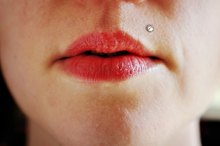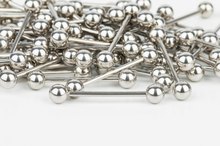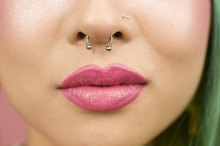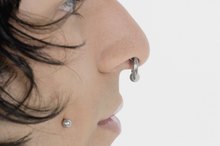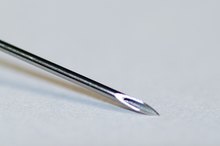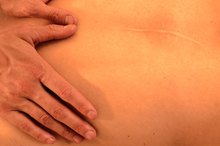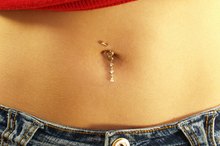How to Get Rid of a Keloid From Piercing
During the healing period of a piercing and after the piercing is healed, you may encounter a keloid on and around your new piercing. Keloids are scar tissue that result from a hereditary condition, causing the skin to raise and turn pink or red, residing inside or around the hole of your piercing, according to the American Osteopathic College of Dermatology. There are several treatments to remove keloids from a body piercing and any treatments for a keloid should be administered by a licensed, professional dermatologist.
Visit your professional body piercer to determine if your piercing has a keloid. Professional piercers are educated in anatomy and are aware of the difference between a permanent keloid and hypertrophic scarring, which is temporary skin flaw, according to the Association of Professional Piercers 1. If you have a keloid, your piercer will direct you to a dermatologist.
How to Minimize Scarring With Monroe Piercings
Learn More
Wash your hands. Remove the jewelry from your piercing.
Prepare piercing information for a dermatologist appointment. Write down the date you received your piercing, when the keloid began to form and when the keloid increased in size. Note on the paper any itching or side effects that occurred after the piercing.
Nipple Piercing & Hypertrophic Scars
Learn More
Make an appointment with a dermatologist. Show the dermatologist your keloid and your sheet of paper with information about your keloid. Ask the dermatologist about treatment options. Understand that some keloids grow back after removal. Ask the dermatologist about risks of the treatments and the cost.
Tips
Do not receive any additional piercings while undergoing treatments for keloids or in the future.
Warnings
Do not attempt to remove or lance the keloid at home. Avoid any elective cosmetic procedures is you have a history of developing keloids.
Related Articles
References
- Pub Med: Keloid: A case report and review of pathophysiology and differences between keloid and hypertrophic scars
- Harvard Medical School Harvard Health Publishing. Keloids. Updated April 2019.
- NHS. Keloid scars. Updated June 5, 2019.
- University of Michigan Medicine. Keloid scars.
- Medical University of South Carolina. Scar revision & keloid treatment.
- Westra I, Pham H, Niessen FB. Topical silicone sheet application in the treatment of hypertrophic scars and keloids. The Journal of Clinical and Aesthetic Dermatology. 2016;9(10):28-35.
- NYU Langone Health. Recovery & support for scars & keloids.
- Harvard Medical School Harvard Health Publishing. Keloids. Updated April 2019.
- NHS. Keloid scars. Updated June 5, 2019.
- University of Michigan Medicine. Keloid scars.
- Medical University of South Carolina. Scar revision & keloid treatment.
- Morelli Coppola M, Salzillo R, Segreto F, Persichetti P. Triamcinolone acetonide intralesional injection for the treatment of keloid scars: patient selection and perspectives. CCID. Clin Cosmet Investig Dermatol. 2018;11:387-396. doi:10.2147/CCID.S133672
- Westra I, Pham H, Niessen FB. Topical silicone sheet application in the treatment of hypertrophic scars and keloids. The Journal of Clinical and Aesthetic Dermatology. 2016;9(10):28-35.
- Barara M, Chander R, Mendiratta V. Cryotherapy in treatment of keloids: evaluation of factors affecting treatment outcome. J Cutan Aesthet Surg. 2012;5(3):185-. doi:10.4103/0974-2077.101376
- Rathee M, Kundu R, Tamrakar A. Custom made pressure appliance for presurgical sustained compression of auricular keloid. Ann Med Health Sci Res. 2014;4(8):147-. doi:10.4103/2141-9248.138040
- Xu J, Yang E, Yu N, Long X. Radiation therapy in keloids treatment. Chinese Medical Journal. 2017;130(14):1715-1721. doi:10.4103/0366-6999.209896
- Gauglitz, G. Management of keloids and hypertrophic scars: current and emerging options. Clin Cosmet Investig Dermatol. 2013;6:103–114. doi:10.2147/CCID.S35252
- Shah VV, Aldahan AS, Mlacker S, Alsaidan M, Samarkandy S, Nouri K. 5-fluorouracil in the treatment of keloids and hypertrophic scars: a comprehensive review of the literature. Dermatol Ther (Heidelb). 2016;6(2):169-183. doi:10.1007/s13555-016-0118-5
- Stephanides S, Rai S, August PJ, Ferguson JE, and Madan V. Treatment of refractory keloids with pulsed dye laser alone and with rotational pulsed dye laser and intralesional corticosteroids. Laser Therapy. 2011;20(4):279-286. doi:10.5978/islsm.12-OR-01
- Arno AI, Gauglitz GG, Barret JP, Jeschke MG. Up-to-date approach to manage keloids and hypertrophic scars: a useful guide. Burns. 2014;40(7):1255-1266. doi:10.1016/j.burns.2014.02.011
- Kaiser Permanente. Keloid scars. Updated April 1, 2019.
- NYU Langone Health. Recovery & support for scars & keloids.
- van Leeuwen MCE, Bulstra AEJ, Ket JCF, Ritt MJPF, van Leeuwen PAM, Niessen FB. Intralesional cryotherapy for the treatment of keloid scars. Plastic and Reconstructive Surgery - Global Open. 2015;3(6):e437-. doi:10.1097/GOX.0000000000000348
- Weshahy AH, Abdel Hay R. Intralesional cryosurgery and intralesional steroid injection: a good combination therapy for treatment of keloids and hypertrophic scars. Dermatol Ther. 2012;25(3):273-276. doi:10.1111/j.1529-8019.2012.01456.x
- Wilson, AM. Eradication of keloids: surgical excision followed by a single injection of intralesional 5-fluorouracil and botulinum toxin. Canadian Journal of Plastic Surgery. 2013;21(2):87-91. doi:10.1177/229255031302100208
Writer Bio
Maude Coffey retired after 10 years working as a professional body modification artist in the tattoo industry. She is certified in principles of infection control and blood-borne pathogens. Coffey received additional training and classes, such as anatomy, jewelry standards and aftercare, from the Association of Professional Piercers. Coffey aims to educate about safe tattooing and piercing practices while writing for various websites.
